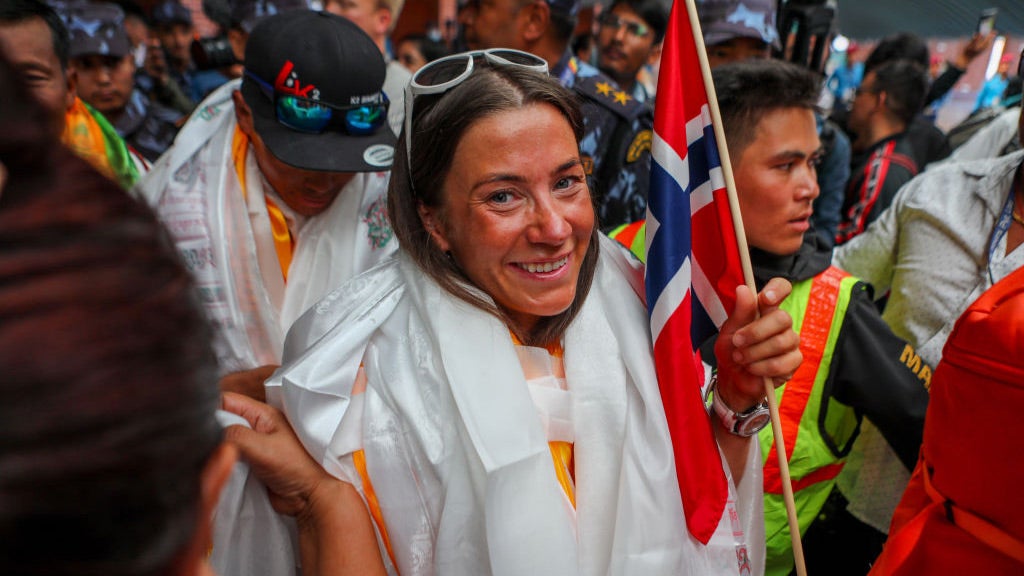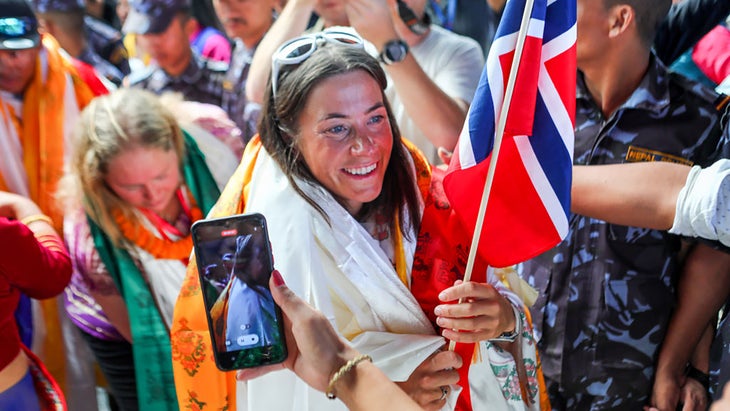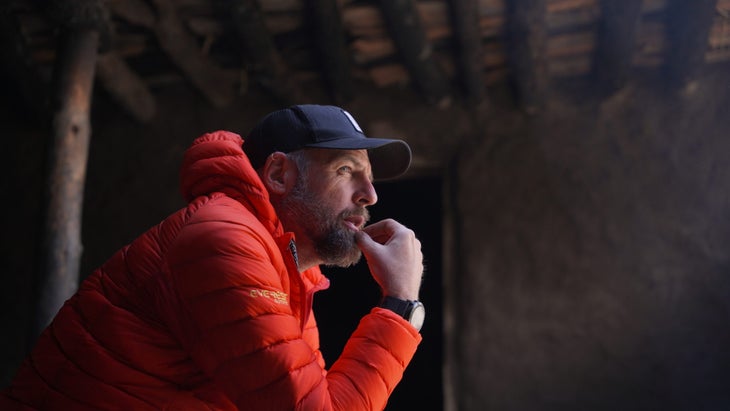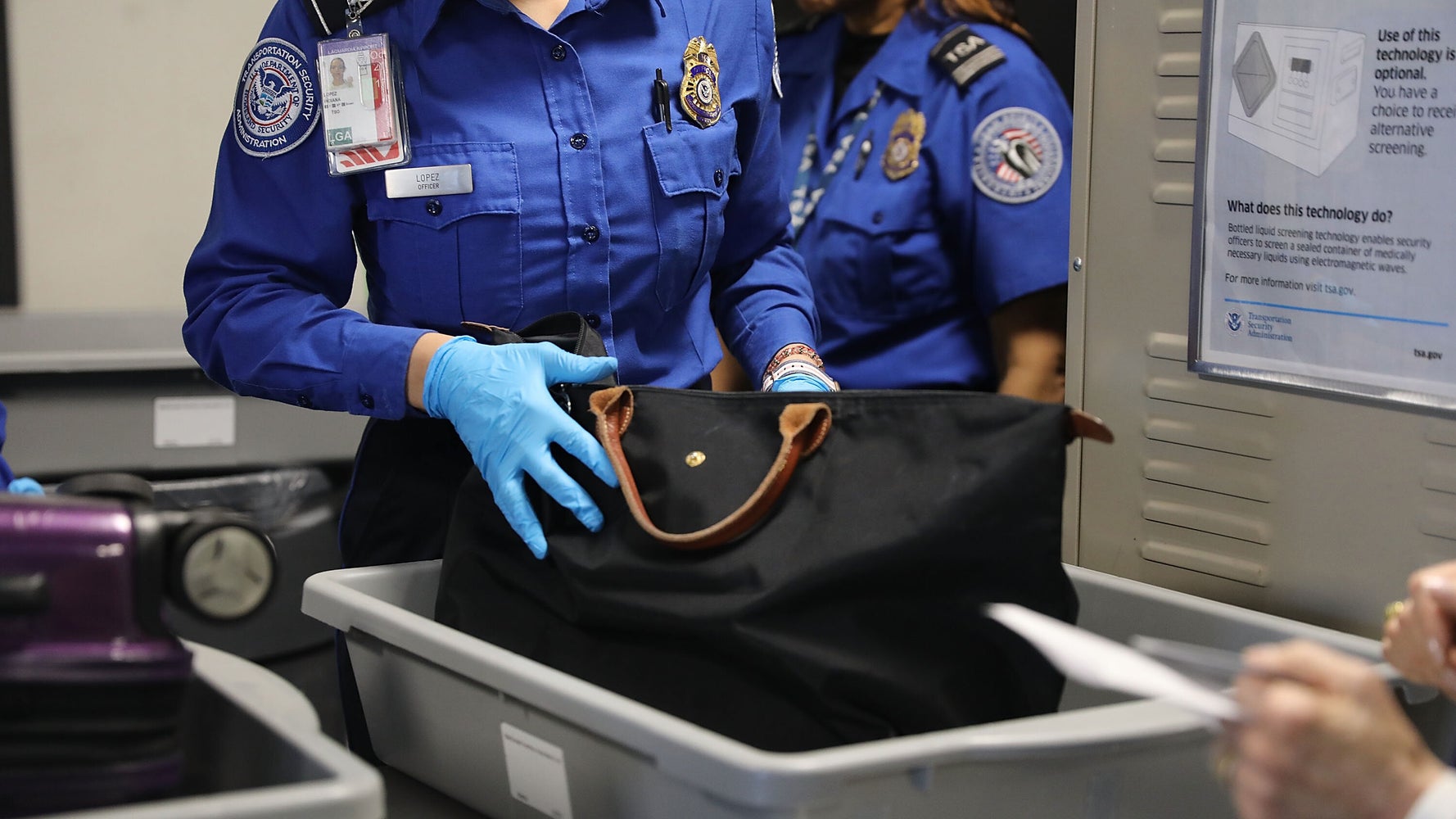
When I heard that the famed Norwegian mountaineer Kristin Harila was back in Kathmandu this spring, I texted her to see if she was interested in connecting for an interview. Harila, 39, rose to fame within the global mountaineering scene in 2023, when she and Nepali climber Tenjen “Lama” Sherpa successfully climbed the world’s 14 peaks above 8,000 meters in just 92 days. The expedition still stands as a world record.
“I almost don’t do interviews anymore,” Harila told me. “It’s just written wrong all the time, even in the smallest outdoor magazines in Norway, they just write to get headlines.”
I met with Harila in the crowded breakfast hall of the Aloft Hotel, towering above the beating heart of Kathmandu’s Thamel tourist district. Harila was dressed in a patchwork hoodie and was already working her way through an omelet and toast. The room buzzed with Indian tourists on holiday and conspicuous trekkers sporting bright polypro shirts and pants that zip off at the knee.
Perhaps nobody in the mountaineering world has experienced such emotional highs and lows as Harila over the past two years. Criticism about her record-chasing expedition popped up as she was still climbing peaks. Within days of her July 27, 2023 ascent of K2, murmurs spread within the climbing scene that she and Lama had charged past a dying mountain worker on their way to the summit. Harila has since spoken publicly about the incident and provided proof that she and Lama spent several hours trying to save the man
Then, in August 2023, disaster struck: Lama died in an avalanche on 26,335-foot Shishapangma in Tibet. He had been guiding American climber Gina Marie Rzucidlo, who was seeking to become the first American woman to complete all 14 8,000 meter peaks. Minutes after the deadly slide, another avalanche claimed the lives of Anna Gutu, another American, and her guide Mingmar Sherpa. The deaths had a major impact on Harila.
“I haven’t had any solace since K2 and since Lama passed away,” she said. “I’m trying to find my way back to the mountains in some way, but I don’t know if I’ll ever be able to. I’m hoping to have a nice time now, but let’s see how it goes.”

Harila is back in Nepal this year attempting to secure permits to return to Tibet to look for Lama and Rzucidlo, who are still buried somewhere on Shishapangma. She first plans to trek into the Everest region alongside Lama’s oldest son to acclimatize while she waits. If she has time, she said, she would do something casual like climb Nuptse or run the Everest Marathon.
“I wanted to search for Lama again, but I was sure that it’s my last. I will do shorter trips, but not two months,” she told me. “I am done with long expeditions.”
This trip to Tibet is Harila’s second attempt to locate Lama and Rzucidlo, after an unsuccessful one last October. In May, 2024, climber Nirmal “Nims” Purja and his Elite Exped guides located the bodies of Gutu and Mingmar. For her 2025 search Harila is hoping to bring a helicopter, a French rescue pilot, and an RECCO scanner that could ping signals off the reflectors in jackets worn by Lama and Rzucidlo.
The outfitter that helped Harila achieve her record, Seven Summits Treks, is currently working on the complex logistics and permitting of Harila’s mission.
“There is no one else that has any interest in finding them, other than me, Seven Summits, and Lama and Gina’s family. I’m paying for it all myself” Harila told me. “I don’t really care about money.”
As we talked, Harila barely ate. She spoke quickly and emphatically. “For everyone it would be good to get them home,” she said. “And if we’re not successful I’ll probably try to come back in the autumn and try again. I’m trying to say it’s the last time now, but I know it will be hard if there’s an expedition to say ‘I’m not coming.’”
I asked Harila if she felt that her own record-setting expedition in 2023 fueled the culture that led to the Shishapangma disaster.
“I can only say that I wasn’t there,” she answered. “That’s a lesson I learned from K2. The only people that can say what happened on Shishapangma, are dead. The four of them. So I cannot say anything for them, and none of them are here to defend themselves.”
Harila then added: “I never thought it would end this way. If I knew, I never would have done it. A lot of these accidents that happened shouldn’t have happened.”
Our conversation meandered, and as Harila stood up to get a coffee, a middle-aged British trekker in a neon-green running shirt leaned over to me and asked: “I’m sorry to bother, but is that…” He didn’t mention her name, only raising his eyebrows in awe. I confirmed it was her. “Wow,” he said. “Just, wow.”
Harila recounted her 2024 trip to Tibet to try and locate the missing climbers. Her fears that the bodies are located in one of two yawning crevasses were diminished by her own investigation: a climbing sherpa had survived the slide intact, and others found Lama’s backpack and Rzucidlo’s pants and shoes.
These days Harila is financially supporting Lama’s two sons, aged 15 and 18, and trying to get them to Norway to attend school. She told me about the charitable foundation she established in Norway, called the Lama Sherpa Foundation, which strives to create safety guidelines for mountain workers in Nepal. Harila hopes to someday create a third-party certification program for expedition companies, climbers, and high-altitude workers. “We just need to do it safer, and in a better way,” she said.

She shared her dreams of having a farm in Norway and trying out other sports, like running and triathlon.
I felt somewhat awkward as I listened to Harila share her future hopes and dreams. Like many people in the climbing world, I had watched Harila’s life unravel over social media throughout late 2023 and 2024. The 2023 expedition made her famous, but after the K2 controversy Harila went through a painful breakup with her then-boyfriend, and that was followed by Lama’s death. Each event was personal and also public.
I asked if Harila felt her fame led to her being treated unfairly by media. “Yeah, but not only because of all the people writing wrong things about me,” she said. “Of course I had like, maybe, 20,000 negative comments and hate threats on social media after K2.”
She continued: “I probably had more than 200 people write that they were coming to kill me. I have them every day, still. I still have nightmares about everything,” she said. “Today I woke up, and this is like, what comes in in social media, like every day.”
She took out her phone and showed me a series of screenshots of inflammatory social media comments in Norwegian and English that proved her point. “People still believe the story, and this is like every day still,” she said.
But social media is a necessary evil in her life. Harila admitted that, these days, professional climbers cannot fund expeditions to 8,000-meter peaks without maintaining a healthy presence on social media sites like Instagram. Being an influencer is just part of the job—at best, Harila said, the platforms allow her to express herself directly to the world.
This final point reminded me of my first meeting with Harila—it was in the lobby of this same hotel in the summer of 2022, minutes after she had returned from her first successful ascent of 27,838-foot Makalu. At the time, Harila was sunburned, weary, and glowing, full of fire and conviction to show the world that women could climb just fast—or even faster—than men. At the time I was struck by her conviction and confidence: her expression of strength, demonstrated wholly, one cramponed foot step at a time.
Less than three years later, the mountains appear to be a different force in Harila’s life: a place of mourning and vitriol; somewhere to acclimatize on the way to recover the bodies of close friends.
As we parted, Harila walked me into the polished marble lobby of the hotel where that British trekker in the green shirt waited. He told us about his upcoming hike to Everest Base Camp, a lifelong dream, and asked if he could take a selfie. I offered to take a few photos of them together. Posing against a plate-glass window, Harlia and the man beamed. He thanked her profusely, heaping her with praise. In that moment, I saw her light again.
“See,” she said. “Some people still appreciate me.”

Ben Ayers has covered Mount Everest climbing season for Outside since 2021. He is a filmmaker, journalist, and adventurer who splits his time between Vermont and Nepal. In 2016 he led an expedition to document the last harvest of wild cliff honey by Nepal’s Kulung Rai people for National Geographic.
The post Kristin Harila Is Searching the Himalayas for Tenjen Sherpa—and Solace appeared first on Outside Online.















